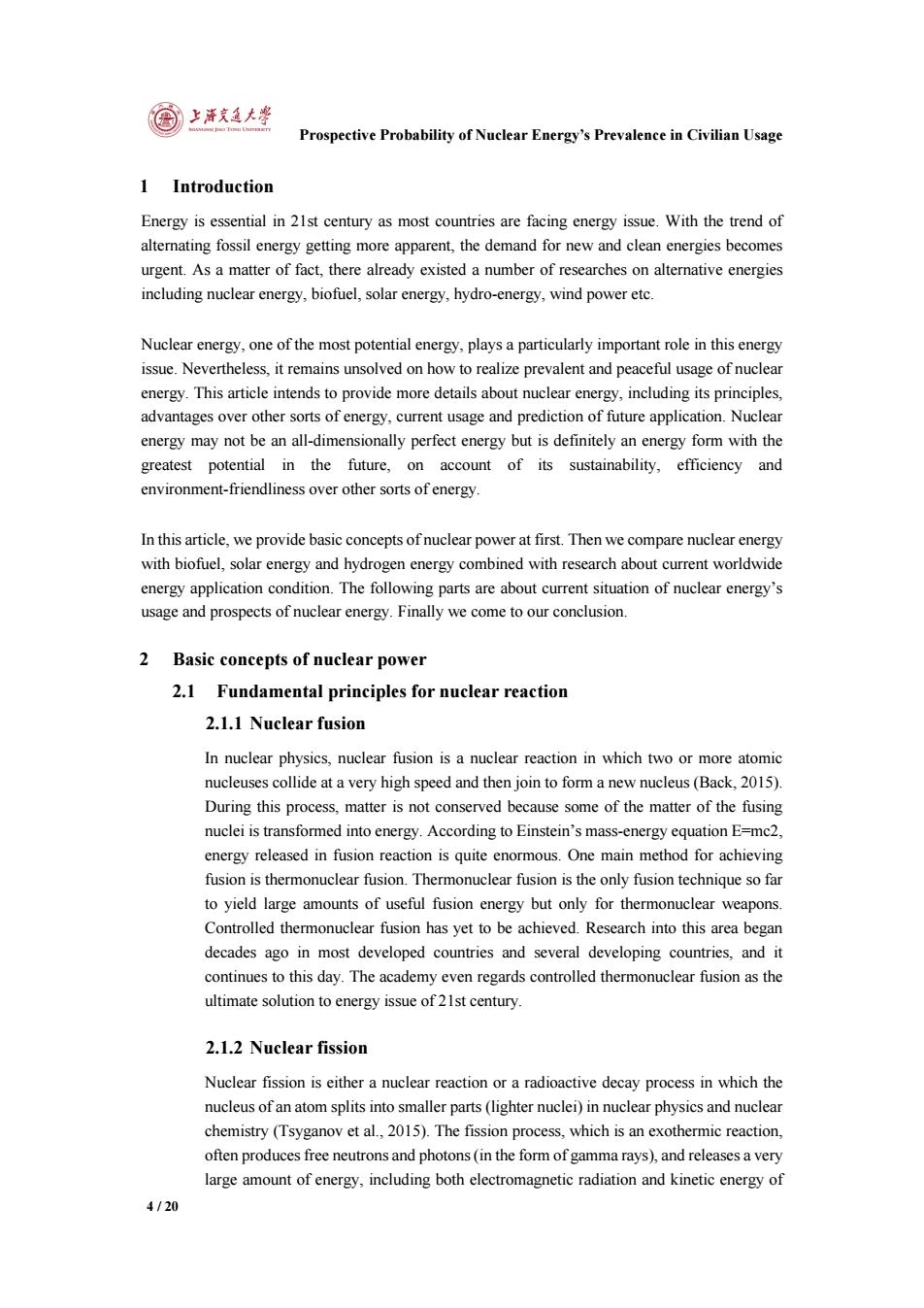正在加载图片...

上充益大粤 Prospective Probability of Nuclear Energy's Prevalence in Civilian Usage 1 Introduction Energy is essential in 21st century as most countries are facing energy issue.With the trend of alternating fossil energy getting more apparent,the demand for new and clean energies becomes urgent.As a matter of fact,there already existed a number of researches on alternative energies including nuclear energy,biofuel,solar energy,hydro-energy,wind power etc. Nuclear energy,one of the most potential energy,plays a particularly important role in this energy issue.Nevertheless,it remains unsolved on how to realize prevalent and peaceful usage of nuclear energy.This article intends to provide more details about nuclear energy,including its principles, advantages over other sorts of energy,current usage and prediction of future application.Nuclear energy may not be an all-dimensionally perfect energy but is definitely an energy form with the greatest potential in the future,on account of its sustainability,efficiency and environment-friendliness over other sorts of energy. In this article,we provide basic concepts of nuclear power at first.Then we compare nuclear energy with biofuel,solar energy and hydrogen energy combined with research about current worldwide energy application condition.The following parts are about current situation of nuclear energy's usage and prospects of nuclear energy.Finally we come to our conclusion. 2 Basic concepts of nuclear power 2.1 Fundamental principles for nuclear reaction 2.1.1 Nuclear fusion In nuclear physics,nuclear fusion is a nuclear reaction in which two or more atomic nucleuses collide at a very high speed and then join to form a new nucleus(Back,2015). During this process,matter is not conserved because some of the matter of the fusing nuclei is transformed into energy.According to Einstein's mass-energy equation E=mc2, energy released in fusion reaction is quite enormous.One main method for achieving fusion is thermonuclear fusion.Thermonuclear fusion is the only fusion technique so far to yield large amounts of useful fusion energy but only for thermonuclear weapons. Controlled thermonuclear fusion has yet to be achieved.Research into this area began decades ago in most developed countries and several developing countries,and it continues to this day.The academy even regards controlled thermonuclear fusion as the ultimate solution to energy issue of 21st century. 2.1.2 Nuclear fission Nuclear fission is either a nuclear reaction or a radioactive decay process in which the nucleus of an atom splits into smaller parts (lighter nuclei)in nuclear physics and nuclear chemistry(Tsyganov et al.,2015).The fission process,which is an exothermic reaction, often produces free neutrons and photons(in the form of gamma rays),and releases a very large amount of energy,including both electromagnetic radiation and kinetic energy of 4/20Prospective Probability of Nuclear Energy’s Prevalence in Civilian Usage 4 / 20 1 Introduction Energy is essential in 21st century as most countries are facing energy issue. With the trend of alternating fossil energy getting more apparent, the demand for new and clean energies becomes urgent. As a matter of fact, there already existed a number of researches on alternative energies including nuclear energy, biofuel, solar energy, hydro-energy, wind power etc. Nuclear energy, one of the most potential energy, plays a particularly important role in this energy issue. Nevertheless, it remains unsolved on how to realize prevalent and peaceful usage of nuclear energy. This article intends to provide more details about nuclear energy, including its principles, advantages over other sorts of energy, current usage and prediction of future application. Nuclear energy may not be an all-dimensionally perfect energy but is definitely an energy form with the greatest potential in the future, on account of its sustainability, efficiency and environment-friendliness over other sorts of energy. In this article, we provide basic concepts of nuclear power at first. Then we compare nuclear energy with biofuel, solar energy and hydrogen energy combined with research about current worldwide energy application condition. The following parts are about current situation of nuclear energy’s usage and prospects of nuclear energy. Finally we come to our conclusion. 2 Basic concepts of nuclear power 2.1 Fundamental principles for nuclear reaction 2.1.1 Nuclear fusion In nuclear physics, nuclear fusion is a nuclear reaction in which two or more atomic nucleuses collide at a very high speed and then join to form a new nucleus (Back, 2015). During this process, matter is not conserved because some of the matter of the fusing nuclei is transformed into energy. According to Einstein’s mass-energy equation E=mc2, energy released in fusion reaction is quite enormous. One main method for achieving fusion is thermonuclear fusion. Thermonuclear fusion is the only fusion technique so far to yield large amounts of useful fusion energy but only for thermonuclear weapons. Controlled thermonuclear fusion has yet to be achieved. Research into this area began decades ago in most developed countries and several developing countries, and it continues to this day. The academy even regards controlled thermonuclear fusion as the ultimate solution to energy issue of 21st century. 2.1.2 Nuclear fission Nuclear fission is either a nuclear reaction or a radioactive decay process in which the nucleus of an atom splits into smaller parts (lighter nuclei) in nuclear physics and nuclear chemistry (Tsyganov et al., 2015). The fission process, which is an exothermic reaction, often produces free neutrons and photons (in the form of gamma rays), and releases a very large amount of energy, including both electromagnetic radiation and kinetic energy of